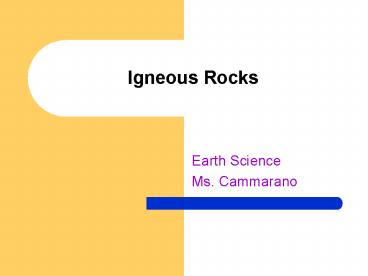Igneous Rocks PowerPoint PPT Presentation
1 / 28
Title: Igneous Rocks
1
Igneous Rocks
- Earth Science
- Ms. Cammarano
2
Igneous Rocks- Fire Rocks
- Igneous rocks are formed by the crystallization
of molten rock . - Molten is liquid minerals and
- rocks.
3
Igneous Rocks
- Liquid rock BENEATH the surface is called MAGMA
- Liquid rock ABOVE the surface is called LAVA
4
Intrusive Igneous Rocks
- When igneous rocks form BENEATH the surface from
magma it is called INTRUSIVE
5
Extrusive Igneous Rocks
- When igneous rocks forms ABOVE the surface from
lava it is called EXTRUSIVE
6
(No Transcript)
7
How Do We Identify Igneous Rocks?
- ESRT!!!
- Identification is done by looking at the CRYSTAL
SIZE and TEXTURE within the rock. - When magma or lava cools it forms a network of
interlocking crystals
Interlocking Crystals
8
Crystal Size- Grain Size
- The size of the CRYSTALS in an igneous rock
depends on the conditions under which it was
formed
Large Crystals
NO CRYSTALS
9
Slow Cooling Magma- Intrusive
- When magma cools slowly underground, INTRUSIVE,
large crystals are formed. - If it cools slow CRYSTALS will GROW!!!
10
Fast Cooling Lava- Extrusive
- When lava cools quickly above ground, EXTRUSIVE,
smaller crystals are formed. - If it cools too fast CRYSTALS WONT LAST!
11
Fast- wont last
- Cools too fast--- small crystals- small cookies
12
Slow- Crystals Grow
- Slow- time to grow- Big Cookies!
13
No Crystals
- If lava cools quickly no crystals are formed.
- This is called Non-Crystalline. Crystal need
time to form.
No Crystals!
14
Texture
- Big crystals have a rough, Coarse texture.
15
Fine texture
- Small crystals have a smooth, FINE texture.
16
No Crystals
- Glassy
- Vesicular- Gas Pockets pop and leave holes in the
rock.
Gas Pocket
17
(No Transcript)
18
Environment of Formation
- Answer the following questions.
- If the rock is a non-crystalline with a glassy
texture the rock was formed in a ________
environment. - Extrusive (Volcanic)
- A rock that has a coarse texture and large
crystals (1mm to 10mm) is_________. - Intrusive (Plutonic)
19
Color and Composition
- Felsic Rocks that are light in color and have a
low density. - Obsidean, Pumice, Rhyolite, Granite, Pegmatite
- Mafic Rocks that are dark in color and have a
high density. - Basalt, Scoria, Gabbro, Peridotite
20
(No Transcript)
21
Minerals
- Use the ESRT to find the rocks mineral
composition by reading the table straight down
from the rocks name.
22
(No Transcript)
23
Questions
- The diagram below represents four rock samples.
Which rock was formed from slow cooling in a
plutonic environment? - 4- Large interlocking
- Crystals. Slow crystals
- Grow!
24
Questions
- The diagram below represents four rock samples.
Which rock was formed by rapid cooling in a
volcanic lava flow? - 2- too fast- crystals
- Wont last!
25
DO NOW
Which rock sample can be classified as a rock
with interlocking crystals.
26
DO NOW
- Basalt (E) is a dark colored crystalline rock
that formed when magma cooled and solidified
slowly under the surface of the earth. - Rock B is classified as an
- 1. Extrusive igneous rock with a coarse texture
and felsic composition - 2. Intrusive igneous rock with a fine texture and
mafic composition - 3. Intrusive igneous rock with a course texture
and felsic composition - 4. Intrusive igneous rock with a fine texture and
mafic composition.
27
(No Transcript)
28
(No Transcript)

